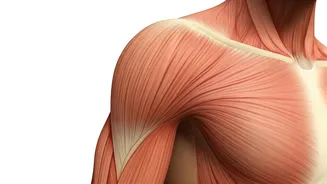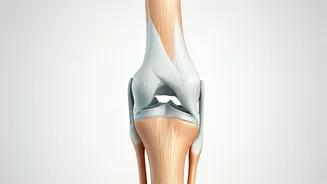Pendulum Exercises: Gentle Starts
Pendulum exercises are an excellent starting point for those dealing with shoulder pain. To perform this exercise, stand with your feet shoulder-width
apart, and let your painful arm hang down. Gently swing your arm forward and backward, side to side, and in small circles. The key here is to keep the movement controlled and pain-free. If you experience any sharp pain, stop immediately. Start with just a few minutes of swinging in each direction, and gradually increase the duration and the size of the circles as your shoulder starts feeling better. This exercise helps to increase blood flow and gently stretch the shoulder muscles without putting excessive strain on the joint. It is a fantastic way to introduce movement and flexibility gradually, supporting faster healing.
Cross-Body Stretch: Targeting Pain
The cross-body stretch directly addresses tightness in the shoulder. To perform this stretch, bring your arm across your body, holding it with your opposite hand just above the elbow. Gently pull your arm towards your body, holding the stretch for about 20-30 seconds. You should feel a stretch in the back of your shoulder and the surrounding muscles. It’s important to avoid overstretching or forcing the movement. Breathe deeply while you hold the stretch, as this helps to relax the muscles and increase the stretch's effectiveness. This stretch specifically targets the posterior shoulder capsule, which often becomes stiff and contributes to pain. Regularly practicing this stretch can help to improve shoulder flexibility and reduce pain related to limited mobility.
Wall Walks: Incremental Range
Wall walks are a gradual way to regain shoulder range of motion. Stand facing a wall and place your fingertips on the wall at shoulder height. Slowly “walk” your fingers up the wall as far as you can comfortably go without pain, then gradually walk them back down. The goal is to gradually increase the height you can reach with your fingers. This exercise not only increases mobility but also strengthens the shoulder muscles as you are lifting your arm. Be patient with this exercise; it should be done slowly and steadily. Don't push yourself beyond your limits, and if you feel any sharp pain, stop immediately. Over time, you’ll find that your arm can move further and you will be able to do daily activities more easily.
Doorway Stretch: Chest Opening
This stretch focuses on opening the chest muscles, which can often be tight and contribute to shoulder pain. To perform this exercise, stand in a doorway with your arms bent at 90 degrees, forearms resting against the doorframe. Gently lean forward until you feel a stretch in your chest and shoulders. Hold this stretch for about 20-30 seconds. This stretch is crucial because tight chest muscles can pull the shoulders forward, increasing strain. By opening up the chest, you help to improve posture and reduce the load on the shoulder joint. Make sure your feet remain stable and your core engaged, and don't overstretch – a gentle pull is all that is needed to reap the benefits. Consistent practice of this stretch can help restore normal shoulder mechanics.
External Rotation: Strengthening Support
External rotation exercises are important for strengthening the rotator cuff muscles, which play a crucial role in shoulder stability. To do this exercise, start by holding a light resistance band with your elbow bent at 90 degrees and tucked against your side. Keeping your elbow in place, slowly rotate your forearm outwards, away from your body. Hold for a few seconds, then slowly return to the starting position. This strengthens the external rotators, which help prevent shoulder injuries and improve function. Using a light resistance band is key to avoid overstressing the shoulder muscles. If you don't have a band, you can also use a light dumbbell or even a soup can. Focus on controlled movements to get the most out of the exercise. Doing this regularly can improve the stability and overall function of your shoulders.












